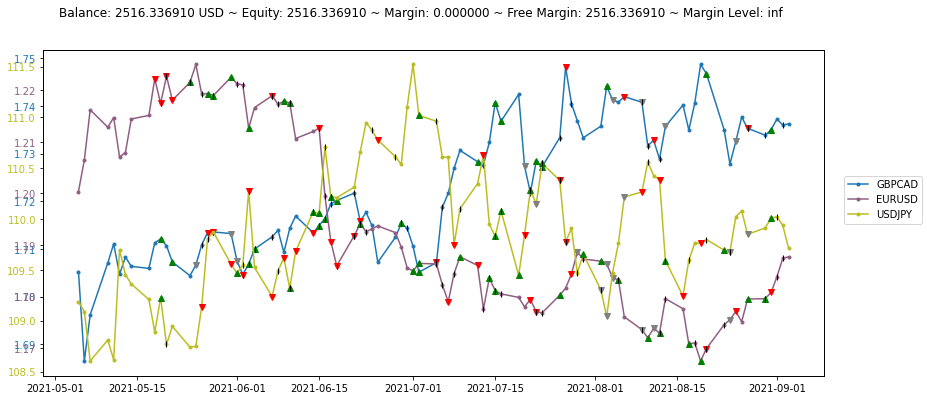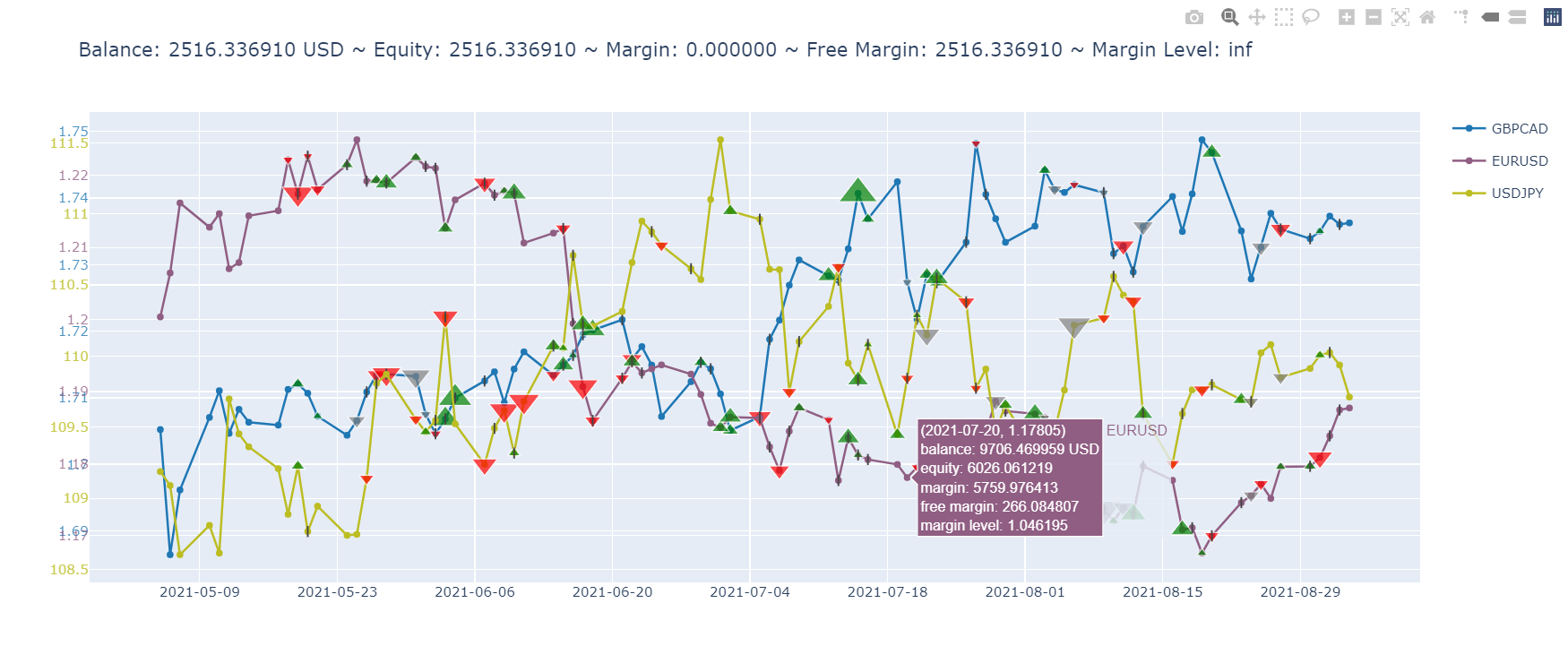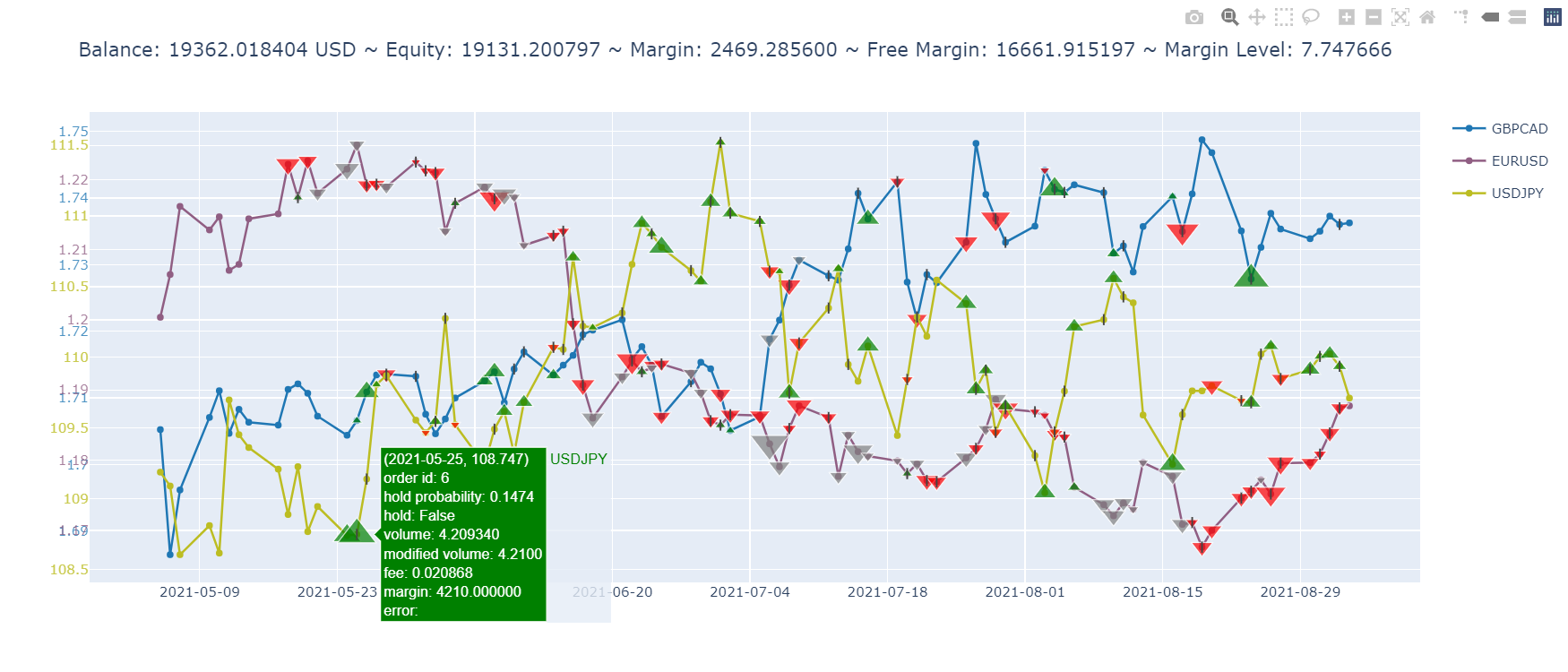MtSim is a simulator for the MetaTrader 5 trading platform alongside an OpenAI Gym environment for reinforcement learning-based trading algorithms. MetaTrader 5 is a multi-asset platform that allows trading Forex, Stocks, Crypto, and Futures. It is one of the most popular trading platforms and supports numerous useful features, such as opening demo accounts on various brokers.
The simulator is separated from the Gym environment and can work independently. Although the Gym environment is designed to be suitable for RL frameworks, it is also proper for backtesting and classic analysis.
The goal of this project was to provide a general-purpose, flexible, and easy-to-use library with a focus on code readability that enables users to do all parts of the trading process through it from 0 to 100. So, gym-mtsim is not just a testing tool or a Gym environment. It is a combination of a real-world simulator, a backtesting tool with high detail visualization, and a Gym environment appropriate for RL/classic algorithms.
Note: For beginners, it is recommended to check out the gym-anytrading project.
Download and install MetaTrader 5 software from here.
Open a demo account on any broker. By default, the software opens a demo account automatically after installation.
Explore the software and try to get familiar with it by trading different symbols in both hedged and unhedged accounts.
pip install gym-mtsimgit clone https://github.com/AminHP/gym-mtsim
cd gym-mtsim
pip install -e .
## or
pip install --upgrade --no-deps --force-reinstall https://github.com/AminHP/gym-mtsim/archive/main.zipThis package is required to run some examples. Install it from here.
This is a data class that contains the essential properties of a symbol. Try to get fully acquainted with these properties in case they are unfamiliar. There are plenty of resources that provide good explanations.
This is another data class that consists of information of an order. Each order has the following properties:
id: A unique number that helps with tracking orders.
type: An enum that specifies the type of the order. It can be either Buy or Sell.
symbol: The symbol selected for the order.
volume: The volume chose for the order. It can be a multiple of volume_step between volume_min and volume_max.
fee: It is a tricky property. In MetaTrader, there is no such concept called fee. Each symbol has bid and ask prices, the difference between which represents the fee. Although MetaTrader API provides these bid/ask prices for the recent past, it is not possible to access them for the distant past. Therefore, the fee property helps to manage the mentioned difference.
entry_time: The time when the order was placed.
entry_price: The close price when the order was placed.
exit_time: The time when the order was closed.
exit_price: The close price when the order was closed.
profit: The amount of profit earned by this order so far.
margin: The required amount of margin for this order.
closed: A boolean that specifies whether this order is closed or not.
This is the core class that simulates the main parts of MetaTrader. Most of its public properties and methods are explained here. But feel free to take a look at the complete source code.
-
Properties:
unit: The unit currency. It is usually USD, but it can be anything the broker allows, such as EUR.balance: The amount of money before taking into account any open positions.equity: The amount of money, including the value of any open positions.margin: The amount of money which is required for having positions opened.leverage: The leverage ratio.free_margin: The amount of money that is available to open new positions.margin_level: The ratio between equity and margin.stop_out_level: If the margin_level drops below stop_out_level, the most unprofitable position will be closed automatically by the broker.hedge: A boolean that specifies whether hedging is enabled or not.symbols_info: A dictionary that contains symbols' information.symbols_data: A dictionary that contains symbols' OHLCV data.orders: The list of open orders.closed_orders: The list of closed orders.current_time: The current time of the system. -
Methods:
download_data: Downloads required data from MetaTrader for a list of symbols in a time range. This method can be overridden in order to download data from servers other than MetaTrader. Note that this method only works on Windows, as the MetaTrader5 Python package is not available on other platforms.save_symbols: Saves the downloaded symbols' data to a file.load_symbols: Loads the symbols' data from a file.tick: Moves forward in time (by a delta time) and updates orders and other related properties.create_order: Creates a Buy or Sell order and updates related properties.close_order: Closes an order and updates related properties.get_state: Returns the state of the system. The result is similar to the Trading tab and History tab of the Toolbox window in MetaTrader software.
This is the Gym environment that works on top of the MtSim. Most of its public properties and methods are explained here. But feel free to take a look at the complete source code.
-
Properties:
original_simulator: An instance of MtSim class as a baseline for simulating the system.simulator: The current simulator in use. It is a copy of the original_simulator.trading_symbols: The list of symbols to trade.time_points: A list of time points based on which the simulator moves time. The default value is taken from the pandas DataFrame.Index of the first symbol in the trading_symbols list.hold_threshold: A probability threshold that controls holding or placing a new order.close_threshold: A probability threshold that controls closing an order.fee: A constant number or a callable that takes a symbol as input and returns the fee based on that.symbol_max_orders: Specifies the maximum number of open positions per symbol in hedge trading.multiprocessing_processes: Specifies the maximum number of processes used for parallel processing.prices: The symbol prices over time. It is used to calculate signal features and render the environment.signal_features: The extracted features over time. It is used to generate Gym observations.window_size: The number of time points (current and previous points) as the length of each observation's features.features_shape: The shape of a single observation's features.action_space: The Gym action_space property. It has a complex structure since stable-baselines does not support Dict or 2D Box action spaces. The action space is a 1D vector of sizecount(trading_symbols) * (symbol_max_orders + 2). For each symbol, two types of actions can be performed, closing previous orders and placing a new order. The former is controlled by the first symbol_max_orders elements and the latter is controlled by the last two elements. Therefore, the action for each symbol is [probability of closing order 1, probability of closing order 2, ..., probability of closing order symbol_max_orders, probability of holding or creating a new order, volume of the new order]. The last two elements specify whether to hold or place a new order and the volume of the new order (positive volume indicates buy and negative volume indicates sell). These elements are a number in range (-∞, ∞), but the probability values must be in the range [0, 1]. This is a problem with stable-baselines as mentioned earlier. To overcome this problem, it is assumed that the probability values belong to the logit function. So, applying the expit function on them gives the desired probability values in the range [0, 1]. This function is applied in the step method of the environment.observation_space: The Gym observation_space property. Each observation contains information about balance, equity, margin, features, and orders. The features is a window on the signal_features from index current_tick - window_size + 1 to current_tick. The orders is a 3D array. Its first dimension specifies the symbol index in the trading_symbols list. The second dimension specifies the order number (each symbol can have more than one open order at the same time in hedge trading). The last dimension has three elements, entry_price, volume, and profit of corresponding order.history: Stores the information of all steps. -
Methods:
seed: The typical Gym seed method.reset: The typical Gym reset method.step: The typical Gym step method.render: The typical Gym render method. It can render in three modes, human, simple_figure, and advanced_figure.close: The typical Gym close method. -
Virtual Methods:
_get_prices: It is called in the constructor and calculates symbol prices._process_data: It is called in the constructor and calculates signal_features._calculate_reward: The reward function for the RL agent.
import pytz
from datetime import datetime, timedelta
from gym_mtsim import MtSimulator, OrderType, Timeframe, FOREX_DATA_PATH
sim = MtSimulator(
unit='USD',
balance=10000.,
leverage=100.,
stop_out_level=0.2,
hedge=False,
)
if not sim.load_symbols(FOREX_DATA_PATH):
sim.download_data(
symbols=['EURUSD', 'GBPCAD', 'GBPUSD', 'USDCAD', 'USDCHF', 'GBPJPY', 'USDJPY'],
time_range=(
datetime(2021, 5, 5, tzinfo=pytz.UTC),
datetime(2021, 9, 5, tzinfo=pytz.UTC)
),
timeframe=Timeframe.D1
)
sim.save_symbols(FOREX_DATA_PATH)sim.current_time = datetime(2021, 8, 30, 0, 17, 52, tzinfo=pytz.UTC)
order1 = sim.create_order(
order_type=OrderType.Buy,
symbol='GBPCAD',
volume=1.,
fee=0.0003,
)
sim.tick(timedelta(days=2))
order2 = sim.create_order(
order_type=OrderType.Sell,
symbol='USDJPY',
volume=2.,
fee=0.01,
)
sim.tick(timedelta(days=5))
state = sim.get_state()
print(
f"balance: {state['balance']}, equity: {state['equity']}, margin: {state['margin']}\n"
f"free_margin: {state['free_margin']}, margin_level: {state['margin_level']}\n"
)
state['orders']balance: 10000.0, equity: 10717.58118589908, margin: 3375.480933228619
free_margin: 7342.1002526704615, margin_level: 3.1751271592500743
| Id | Symbol | Type | Volume | Entry Time | Entry Price | Exit Time | Exit Price | Profit | Margin | Fee | Closed | |
|---|---|---|---|---|---|---|---|---|---|---|---|---|
| 0 | 2 | USDJPY | Sell | 2.0 | 2021-09-01 00:17:52+00:00 | 110.02500 | 2021-09-06 00:17:52+00:00 | 109.71200 | 552.355257 | 2000.000000 | 0.0100 | False |
| 1 | 1 | GBPCAD | Buy | 1.0 | 2021-08-30 00:17:52+00:00 | 1.73389 | 2021-09-06 00:17:52+00:00 | 1.73626 | 165.225928 | 1375.480933 | 0.0003 | False |
order1_profit = sim.close_order(order1)
order2_profit = sim.close_order(order2)
# alternatively:
# for order in sim.orders:
# sim.close_order(order)
state = sim.get_state()
print(
f"balance: {state['balance']}, equity: {state['equity']}, margin: {state['margin']}\n"
f"free_margin: {state['free_margin']}, margin_level: {state['margin_level']}\n"
)
state['orders']balance: 10717.58118589908, equity: 10717.58118589908, margin: 0.0
free_margin: 10717.58118589908, margin_level: inf
| Id | Symbol | Type | Volume | Entry Time | Entry Price | Exit Time | Exit Price | Profit | Margin | Fee | Closed | |
|---|---|---|---|---|---|---|---|---|---|---|---|---|
| 0 | 2 | USDJPY | Sell | 2.0 | 2021-09-01 00:17:52+00:00 | 110.02500 | 2021-09-06 00:17:52+00:00 | 109.71200 | 552.355257 | 2000.000000 | 0.0100 | True |
| 1 | 1 | GBPCAD | Buy | 1.0 | 2021-08-30 00:17:52+00:00 | 1.73389 | 2021-09-06 00:17:52+00:00 | 1.73626 | 165.225928 | 1375.480933 | 0.0003 | True |
import gym
import gym_mtsim
env = gym.make('forex-hedge-v0')
# env = gym.make('stocks-hedge-v0')
# env = gym.make('crypto-hedge-v0')
# env = gym.make('mixed-hedge-v0')
# env = gym.make('forex-unhedge-v0')
# env = gym.make('stocks-unhedge-v0')
# env = gym.make('crypto-unhedge-v0')
# env = gym.make('mixed-unhedge-v0')- This will create a default environment. There are eight default environments, but it is also possible to create environments with custom parameters.
import pytz
from datetime import datetime, timedelta
import numpy as np
from gym_mtsim import MtEnv, MtSimulator, FOREX_DATA_PATH
sim = MtSimulator(
unit='USD',
balance=10000.,
leverage=100.,
stop_out_level=0.2,
hedge=True,
symbols_filename=FOREX_DATA_PATH
)
env = MtEnv(
original_simulator=sim,
trading_symbols=['GBPCAD', 'EURUSD', 'USDJPY'],
window_size=10,
# time_points=[desired time points ...],
hold_threshold=0.5,
close_threshold=0.5,
fee=lambda symbol: {
'GBPCAD': max(0., np.random.normal(0.0007, 0.00005)),
'EURUSD': max(0., np.random.normal(0.0002, 0.00003)),
'USDJPY': max(0., np.random.normal(0.02, 0.003)),
}[symbol],
symbol_max_orders=2,
multiprocessing_processes=2
)print("env information:")
for symbol in env.prices:
print(f"> prices[{symbol}].shape:", env.prices[symbol].shape)
print("> signal_features.shape:", env.signal_features.shape)
print("> features_shape:", env.features_shape)env information:
> prices[GBPCAD].shape: (88, 2)
> prices[EURUSD].shape: (88, 2)
> prices[USDJPY].shape: (88, 2)
> signal_features.shape: (88, 6)
> features_shape: (10, 6)
observation = env.reset()
while True:
action = env.action_space.sample()
observation, reward, done, info = env.step(action)
if done:
# print(info)
print(
f"balance: {info['balance']}, equity: {info['equity']}, margin: {info['margin']}\n"
f"free_margin: {info['free_margin']}, margin_level: {info['margin_level']}\n"
f"step_reward: {info['step_reward']}"
)
breakbalance: 9376.891775198916, equity: 9641.936625205548, margin: 3634.1077619051393
free_margin: 6007.828863300409, margin_level: 2.6531785122131852
step_reward: 140.93306243685583
state = env.render()
print(
f"balance: {state['balance']}, equity: {state['equity']}, margin: {state['margin']}\n"
f"free_margin: {state['free_margin']}, margin_level: {state['margin_level']}\n"
)
state['orders']balance: 9376.891775198916, equity: 9641.936625205548, margin: 3634.1077619051393
free_margin: 6007.828863300409, margin_level: 2.6531785122131852
| Id | Symbol | Type | Volume | Entry Time | Entry Price | Exit Time | Exit Price | Profit | Margin | Fee | Closed | |
|---|---|---|---|---|---|---|---|---|---|---|---|---|
| 0 | 119 | USDJPY | Buy | 1.12 | 2021-09-02 00:00:00+00:00 | 109.93700 | 2021-09-03 00:00:00+00:00 | 109.71200 | -248.970123 | 1120.000000 | 0.018884 | False |
| 1 | 118 | EURUSD | Buy | 0.24 | 2021-09-02 00:00:00+00:00 | 1.18744 | 2021-09-03 00:00:00+00:00 | 1.18772 | -4.355531 | 284.985600 | 0.000461 | False |
| 2 | 117 | USDJPY | Sell | 1.94 | 2021-09-01 00:00:00+00:00 | 110.02500 | 2021-09-03 00:00:00+00:00 | 109.71200 | 520.155098 | 1940.000000 | 0.018839 | False |
| 3 | 116 | GBPCAD | Sell | 0.21 | 2021-09-01 00:00:00+00:00 | 1.73728 | 2021-09-03 00:00:00+00:00 | 1.73626 | -1.784594 | 289.122162 | 0.001126 | False |
| 4 | 113 | USDJPY | Sell | 2.24 | 2021-08-30 00:00:00+00:00 | 109.91300 | 2021-09-01 00:00:00+00:00 | 110.02500 | -258.362674 | 2240.000000 | 0.014903 | True |
| ... | ... | ... | ... | ... | ... | ... | ... | ... | ... | ... | ... | ... |
| 114 | 6 | USDJPY | Sell | 1.03 | 2021-05-21 00:00:00+00:00 | 108.94500 | 2021-05-24 00:00:00+00:00 | 108.74000 | 173.893295 | 1030.000000 | 0.021416 | True |
| 115 | 3 | EURUSD | Buy | 0.86 | 2021-05-19 00:00:00+00:00 | 1.21744 | 2021-05-24 00:00:00+00:00 | 1.22150 | 352.419311 | 1046.998400 | -0.000038 | True |
| 116 | 5 | GBPCAD | Sell | 0.94 | 2021-05-21 00:00:00+00:00 | 1.70726 | 2021-05-24 00:00:00+00:00 | 1.70440 | 174.119943 | 1330.148695 | 0.000629 | True |
| 117 | 1 | GBPCAD | Buy | 1.45 | 2021-05-18 00:00:00+00:00 | 1.71128 | 2021-05-24 00:00:00+00:00 | 1.70440 | -961.496723 | 2056.809874 | 0.001105 | True |
| 118 | 2 | GBPCAD | Sell | 0.58 | 2021-05-19 00:00:00+00:00 | 1.71211 | 2021-05-21 00:00:00+00:00 | 1.70726 | 219.514676 | 818.590377 | 0.000284 | True |
119 rows × 12 columns
- Each symbol is illustrated with a separate color.
- The green/red triangles show successful buy/sell actions.
- The gray triangles indicate that the buy/sell action has encountered an error.
- The black vertical bars specify close actions.
env.render('simple_figure')- Clicking on a symbol name will hide/show its plot.
- Hovering over points and markers will display their detail.
- The size of triangles indicates their relative volume.
env.render('advanced_figure', time_format="%Y-%m-%d")import gym
from gym_mtsim import (
Timeframe, SymbolInfo,
MtSimulator, OrderType, Order, SymbolNotFound, OrderNotFound,
MtEnv,
FOREX_DATA_PATH, STOCKS_DATA_PATH, CRYPTO_DATA_PATH, MIXED_DATA_PATH,
)
from stable_baselines3 import A2C
# env = gym.make('forex-hedge-v0')
model = A2C('MultiInputPolicy', env, verbose=0)
model.learn(total_timesteps=1000)
observation = env.reset()
while True:
action, _states = model.predict(observation)
observation, reward, done, info = env.step(action)
if done:
break
env.render('advanced_figure', time_format="%Y-%m-%d")- https://www.mql5.com/en/docs/python_metatrader5
- https://www.metatrader5.com/en/terminal/help/trading_advanced/margin_forex
- https://admiralmarkets.com/education/articles/forex-basics/margin-in-forex-trading-margin-level-vs-margin-call
- https://www.investopedia.com/articles/forex/12/calculating-profits-and-losses-of-forex-trades.asp


